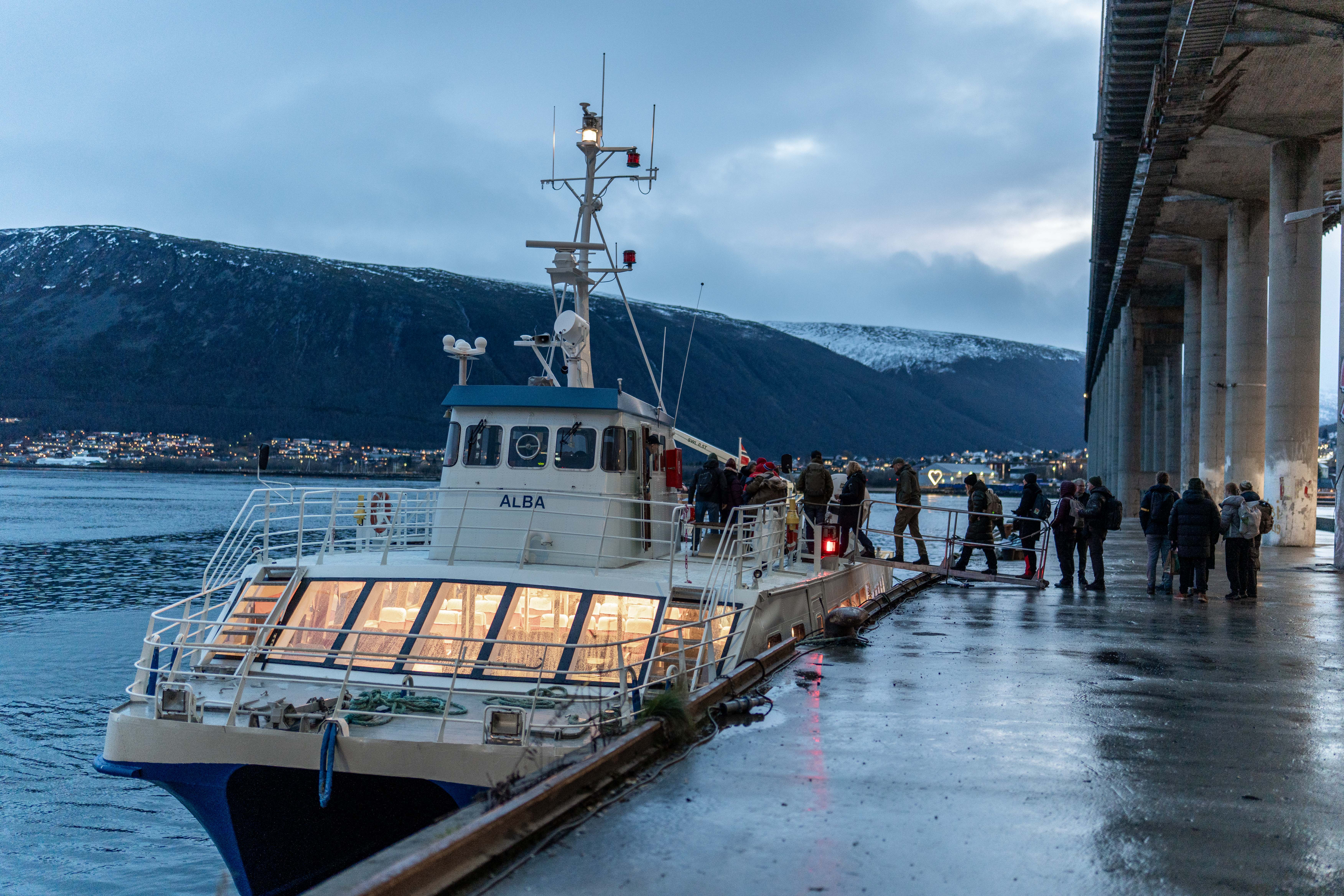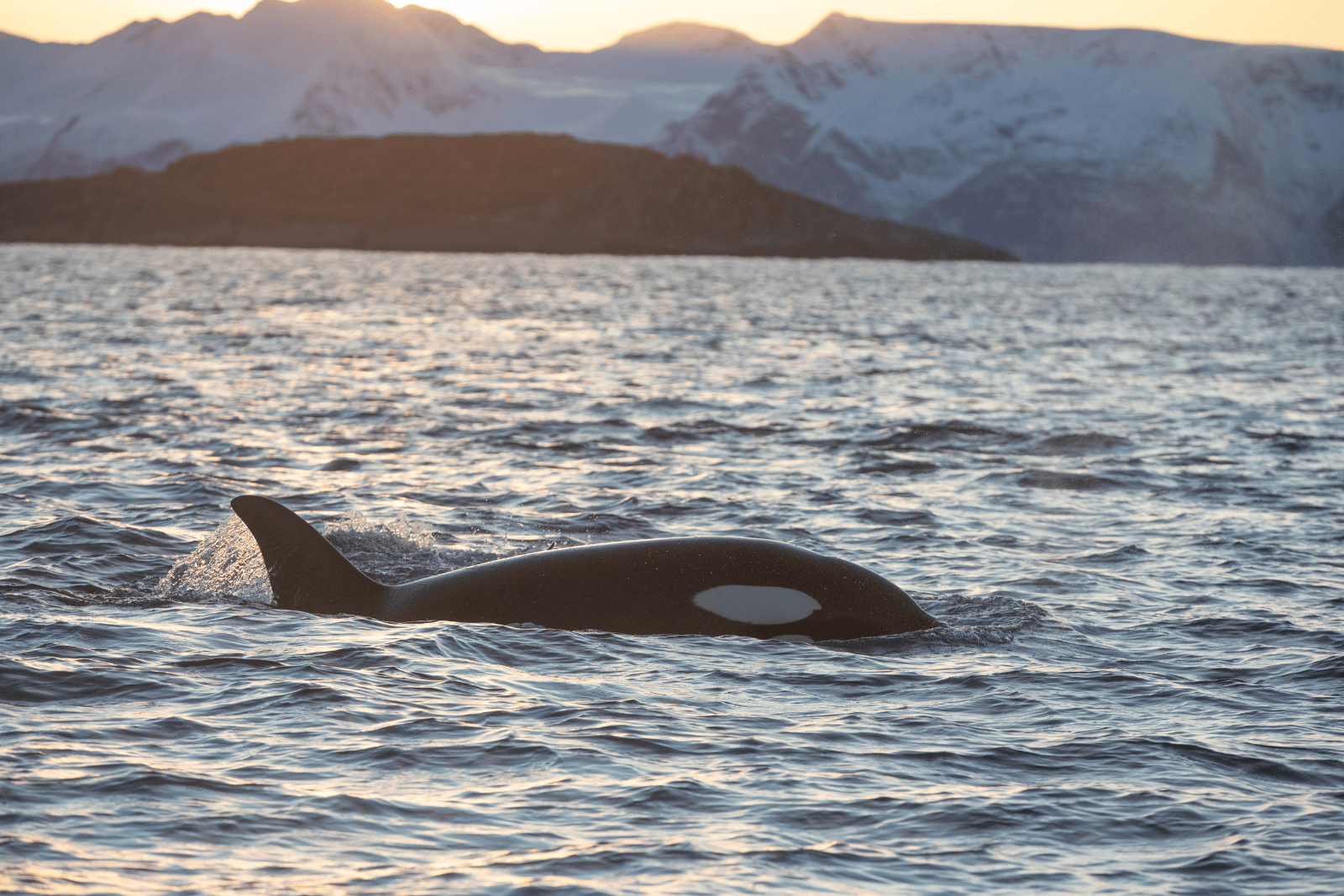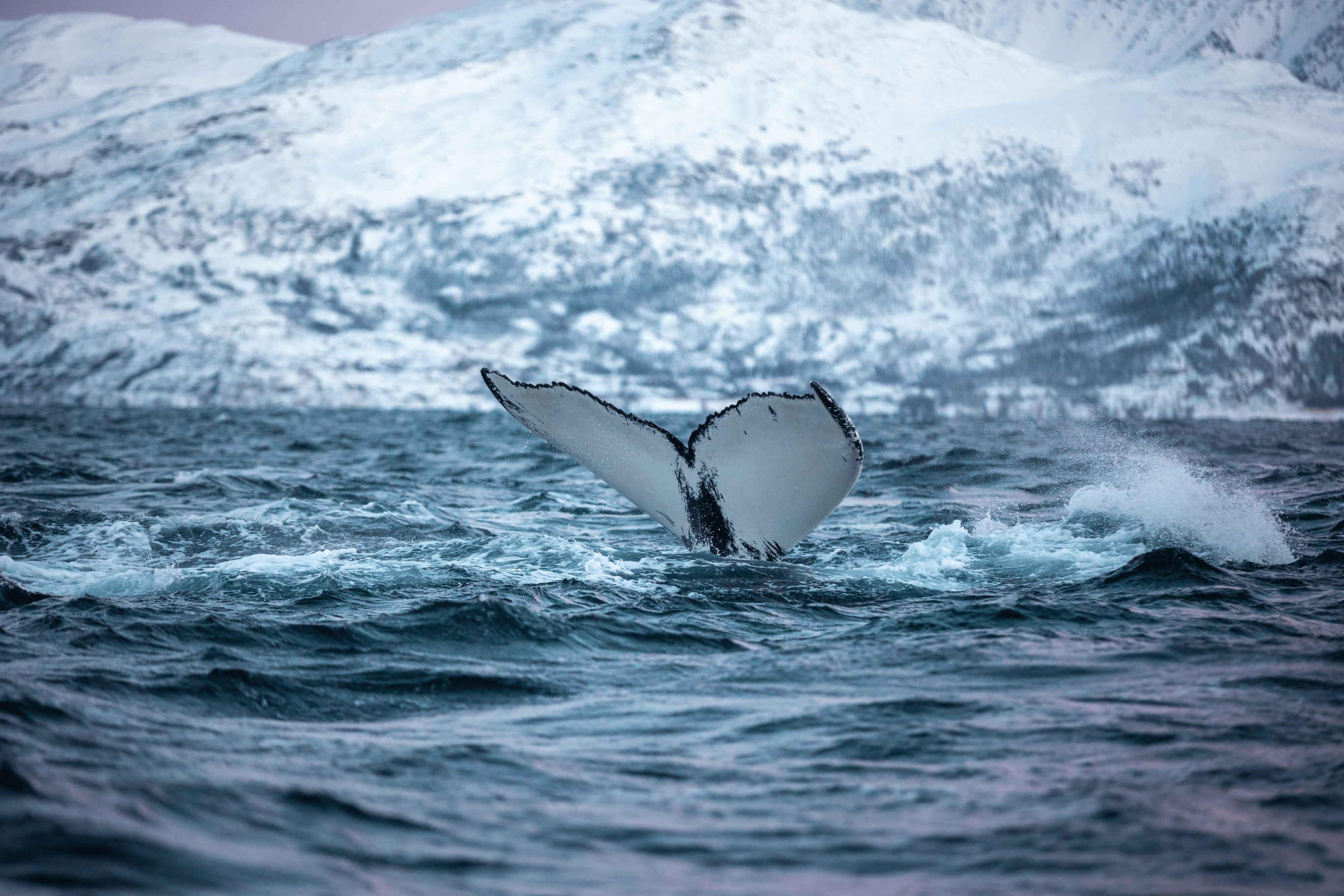
Winter Whale Safari in Tromsø
Witness Orcas & Humpbacks in the Fjords of Northern Norway
Season: November 2025 – January 2026
Location: Tromsø Harbour, Vervet area
Witness the Winter Gathering of Whales
Every winter, the fjords north of Tromsø transform into one of the richest whale-watching grounds in the world. Vast shoals of herring arrive, and with them come humpback whales and killer whales (orcas) — feeding, diving, and sometimes breaching in spectacular fashion.
Step aboard Alba, our classic, comfortable catamaran, and journey deep into the Arctic fjords. As the city fades behind you, snow-covered mountains rise from the sea, and the soft twilight of the polar day lights the horizon. Then — the ocean stirs. A black dorsal fin cuts the water, a humpback exhales, and suddenly the Arctic comes alive.
This is whale watching in Tromsø at its finest: a full-day adventure into the wild.
Key Details
- Season: November 2025 – January 2026
- Meeting Point: Tromsø Harbour, Vervet area, Skansegata 7, 9008 Tromsø (under the Tromsø Bridge, beside The Dock 69°39’ by Scandic Hotel)
- Google Maps
- Check in: 07:45–0815 (directly at boat)
- Departure Time: 08:30am
- Duration: 8 hours (± 1 hour) depending on weather and whale location
- Vessel: : MS Alba – Classic Norwegian catamaran (26m) with new engines & hydrophone
- Facilities: Heated indoor lounge, Outdoor observation decks for panoramic views, toilets onboard, Hydrophone system
- Capacity: Up to 90 passengers (minimum 20 required)
About the Vessel – MS Alba

Built in 1975 by the Westamarin shipyard in Mandal, Norway, Alba has spent nearly five decades carrying passengers along the Norwegian coast. Once a fast ferry, she has since been upgraded with new, low-noise engines and a hydrophone system that our crew uses to listen for whales beneath the surface.

Onboard, you’ll find a heated indoor lounge with panoramic windows, spacious outdoor decks for 360° whale watching, and toilets for comfort during the full-day journey. With capacity for up to 90 guests, Alba is both stable and spacious — her twin-hull catamaran design offers a smoother ride on Arctic seas, so you can enjoy more time where it matters most: with the whales.

What’s Included
✅ Full-day guided whale safari aboard MS Alba
✅ Professional guides & experienced crew
✅ Hot drinks (coffee/tea) & biscuits
✅ Heated indoor lounge & outdoor viewing decks
✅ Toilets & safety equipment
✅ Whale Pass – free rebooking if no whales are sighted
❌ Meals (we recommend bringing a packed lunch or extra snacks for the day)
❌ Seasickness medication (please bring your own if you know you get seasick)
❌ Warm clothing (please dress in layers suitable for Arctic conditions)
❌ Personal expenses (souvenirs, etc.)
The Safari Experience
A voyage into the frozen wild.
Your day begins at Vervet where our crew welcomes you aboard Alba. As we leave the harbour, the Arctic landscape opens up — fjords, mountains, and endless sea.
During the voyage, our guides share stories and insights about the whales and the fragile ecosystem of the north. Once in the feeding grounds, the sea often erupts with life:
- Orcas traveling in pods, surfacing in unison
- Humpbacks diving deep and raising their tail flukes high
- Occasional sightings of fin whales, dolphins, or porpoises
- Seabirds like white-tailed eagles and auks circling above
Every safari is unique, but every encounter is unforgettable.


Itinerary
- 07:45 – Check-in begins at Tromsø Harbour, Vervet area, under the Tromsø Bridge, beside The Dock 69°39’ by Scandic Hotel
- 08:30 – Departure aboard MS Alba. The journey begins as we leave the harbour and head north into the fjords.
- 08:30–11:30 – Scenic voyage through Arctic fjords. Relax in the heated lounge or step outside for breathtaking views of snow-covered mountains and coastal villages. (approx. 3 hrs)
- 11:30–13:30 – Whale watching in the feeding grounds north of Tromsø. Encounters may include orcas, humpbacks, and seabirds.
- 13:30–16:30 – Return voyage to Tromsø (approx. 3 hrs).
- ~16:30 – Arrival back at Vervet Harbour
Note: Timings may vary depending on whale location and sea conditions.
Highlights
Full-Day Arctic Adventure
A complete 8 hour journey from Tromsø, combining scenic fjord cruising with time in the whale feeding grounds.
Whale Encounters
See orcas, humpback whales, and other marine wildlife in their natural Arctic environment.
Spacious & Stable Vessel
Travel aboard Alba, a Norwegian-built catamaran with a heated indoor lounge, panoramic windows, and wide outdoor decks.
Expert Guides
Learn from experienced, multilingual guides who share knowledge about whales and Arctic wildlife.
Whale Pass — See Whales or Come Back Free.
We can’t control nature — but we can make you a promise. If no whales or dolphins are spotted during your trip, you’ll receive a free rebooking for another available safari within the same or following season (same participants, subject to availability, non-cash).
What to Bring (Friendly Tips)
The Arctic can be unpredictable, so come prepared for cold and wind.
We recommend:
- Dress like a local: Layers are your best friend! Start with thermal underwear, add a warm sweater or fleece, and finish with a windproof and waterproof jacket and trousers.
- Keep cozy: A warm hat, gloves, and a scarf (or buff) will make all the difference out on deck.
- Happy feet: Insulated winter boots with good grip are essential — the decks can get cold and sometimes slippery.
- Snacks for the journey: We’ll have coffee, tea, and biscuits onboard, but since this is a full-day trip, we recommend bringing a packed lunch or a few extra snacks.
- Capture the magic: Bring your camera or phone — and don’t forget spare batteries or a power bank, as the cold drains them faster than you think.
- For smoother sailing: If you know you get seasick, it’s smart to take motion sickness tablets before departure.
Pricing - 2025/26
(Per person, incl. VAT – booking fee applies for online reservations)
- NOK 1,950 – Adults (ages 16+)
- NOK 1,750 – Seniors (65+)
- NOK 1,750 – Students (with valid ID)
- NOK 1,450 – Youths (ages 11–15, must be with adult)
- NOK 1,150 – Children (ages 3–10, must be with adult)
- Free – Infants (ages 0–2, must be with adult)
📌 For Travel Professionals:
We collaborate with tour operators, travel agencies, and DMCs under special B2B rates and commission models. If you are a partner, please contact our B2B team for confidential net rates and terms.
Cancellation Policy
- Free cancellation up to 24 hours before departure.
- No refunds for cancellations made less than 24 hours before departure or for no-shows
- Tours cancelled by Arctic Whale Tours due to weather, sea conditions, or unforeseen events will be fully refunded or rebooked.
➡️ For full details, please see our Cancellation Policy page.
Important Information
- Minimum Age: 1 year old. Children under 16 must be accompanied by an adult at all times.
- Accessibility: Not wheelchair or stroller accessible. Please contact us if you have mobility concerns.
- Minimum Group Size: A minimum of 20 passengers is required for the safari to operate.
- Weather & Sea Conditions: Tours may be rescheduled or cancelled for safety reasons. In such cases, you will be offered a full refund or rebooking.
- Whale Sightings: Whale sightings are not guaranteed, but our Whale Pass ensures free rebooking within the same or following season if no whales or dolphins are seen (same participants, subject to availability, non-cash).
- Please meet directly at the dock beneath the Tromsø Bridge in the Vervet area, next to The Dock 69°39’ by Scandic, Skansegata 7, 9008 Tromsø. Our vessel MS Alba will be moored there, and our crew will welcome you on board. There is no reception or indoor check-in area, so boarding takes place directly at the boat. We recommend arriving 20–30 minutes before departure to ensure a smooth check-in.
Plan Your Visit
Make the most of your trip to Tromsø.
Tromsø Harbour (Vervet) is easily accessible by foot, car, or public transport. The boat's boarding location will be confirmed in your booking email.
👉 How to Get Here
Tromsø offers a wide range of accommodations — from cozy guest houses to modern hotels with fjord views. Book early, as winter is peak season!
👉 Where to Stay
Need Help?
Read our FAQs | Contact us
Ready to Join?
Join us aboard Alba for an unforgettable winter safari where Arctic whales take center stage. Book now and experience the wild beauty of Tromsø like never before.

Whale Pass
We proudly offer one of Norway’s most guest-friendly guarantees. If no whales are sighted during your trip, you’ll receive a complimentary rebooking for the next available tour — because every Arctic adventure deserves whales.
Join Us on the Water
Whether you're traveling as a couple, family, or solo adventurer— We’re ready to welcome you aboard.





.jpg)




